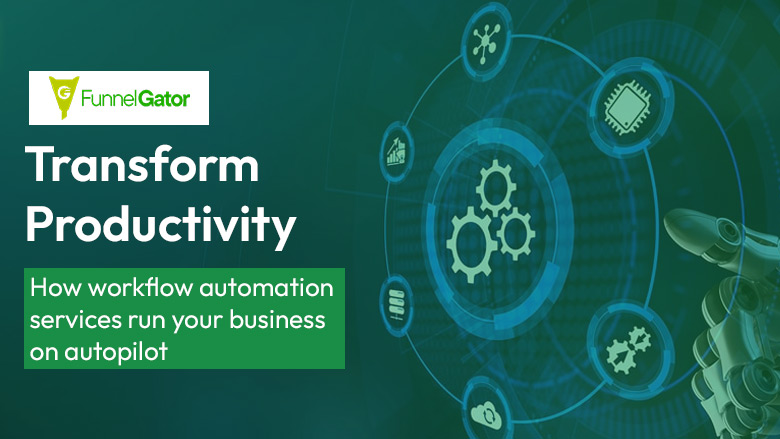
Transform Productivity: How Workflow Automation Services Run Your Business on Autopilot
If your business feels like it’s constantly playing catch-up, juggling client requests, managing approvals, and tracking emails, workflow automation services are what finally break that cycle. This guide explains, in simple terms, how workflow automation software transforms repetitive, manual operations into self-running systems that boost productivity, accuracy, and profits.
We’ll walk through everything from the basics of automating workflows to advanced AI-driven orchestration, covering real-world use cases, ROI frameworks, and the technologies that make it all possible. By the end, you’ll know exactly how to automate workflows and run your business on autopilot, no jargon, no tech background required.
This blog is written for business owners, marketing agencies, and growth-focused teams who want to scale without constantly adding more staff. Suppose you manage sales, marketing, or client operations, and you’ve hit the limits of spreadsheets and manual follow-ups. In that case, this is your blueprint for building a business that runs smoothly, powered by automation, not exhaustion.
Let’s start by understanding why manual processes silently cap growth and how automation turns chaos into consistent, measurable progress.
The Cons of Manual Processes: How Automation Becomes Inevitable
Most growing teams hit a wall without realising it. They keep adding people to manage recurring work instead of optimising the work itself. This creates the Growth-Cap Trap, progress limited by human bandwidth.
Manual processes bring hidden costs:
Time Drain: Each invoice approval or client follow-up requires clicks, checks, and reminders that could have been handled automatically.
Fragmentation: Information scatters across email threads, spreadsheets, and chat messages, leading to inconsistent data.
Error Loops: Duplicate entries or missed updates force rework and compromise decision accuracy.
Morale Drop: Talented employees waste hours on repetitive admin tasks rather than creative, strategic work.
These challenges are exactly what business workflow automation eliminates. When you integrate automated workflow software, repetitive steps become background functions. Tasks trigger themselves; updates sync across systems. A project manager gets alerts only when human input truly matters.
Companies adopting workflow automation solutions often report a 40–70 % reduction in manual workload within the first six months, not by pushing harder, but by working smarter.
What Actually are Workflow Automation Services: From Tasks to End-to-End Processes
Most people equate automation with isolated tasks, sending an email after a form fill or copying data between tools. In reality, modern workflow automation services operate at multiple levels:
A true workflow automation platform unifies people, tools, and data. It doesn’t just automate workflows; it enforces consistency, documents every action, and ensures visibility from start to finish.
At Funnel Gator, we design these systems as “business autopilots”: once set up, they self-trigger, update records, and even escalate approvals without manual follow-up.
Schedule Your Free Workflow Audit
Understanding Workflow Automation Services: Connecting People and Data
Automation succeeds only when information flows freely. Traditional departments, such as marketing, sales, finance, and support, often use separate software that doesn’t communicate with each other. The result: siloed teams, duplicated data, and lost context.
A robust business process workflow automation framework uses integration to remove those walls. APIs, webhooks, and connectors let data move securely between CRMs, spreadsheets, and communication tools.
When a customer signs a contract, for example:
The CRM automatically updates the status.
The finance system generates an invoice.
The project board creates a task.
The client receives a welcome email.
No emails, no hand-offs, no lag.
This connected structure ensures:
Single Source of Truth: Everyone works on the same data set.
Faster Cycle Times: Tasks trigger in seconds, not hours.
Accountability: Every action is logged for transparency.
Scalability: Adding new clients or campaigns requires zero extra staff.
That’s the true foundation of workflow automation software, not just automating clicks but building a reliable nervous system for the entire organization.
Key Components of Workflow Automation: Software and Tools
Behind every efficient automation workflow lies a set of intelligent components working in sync. Let’s look at the core elements that make automated workflow systems effective.
1. Triggers
Events that start an automation – a form submission, a payment received, or a status change. Example: when a lead downloads a guide, the system adds them to a specific marketing automation workflow.
2. Conditions and Rules
Logic gates that decide what happens next (“If A, then B”). They ensure each client journey feels personal without manual segmentation.
3. Actions
The tasks are executed automatically, sending emails, creating invoices, updating CRM fields, posting to Slack, or triggering an email automation workflow.
4. Integrations & APIs
Connect your entire tech stack, CRMs, project managers, and marketing tools into one automated workflow solution. No more copy-pasting between tabs.
5. Dashboards & Analytics
Measure time savings, error rates, and campaign impact through built-in reports. This is where leaders see the benefits of workflow automation quantified.
A good rule of thumb: the best workflow automation software feels invisible. It runs quietly in the background, making teams look faster and more coordinated without adding complexity.
Looking to automate client acquisition too?
See how sales funnel automation software boosts conversions effortlessly
→ internal link: How Smart Businesses Use Sales Funnel Automation Software
Intelligent Automation: Giving Workflows the Power to Think
Traditional workflow automation focuses on repeating instructions, send this, update that. But today’s workflow automation services go far beyond static rules. They now include intelligent automation, where your systems actually learn, adapt, and make smart decisions.
At the heart of intelligent automation are AI, machine learning (ML), and natural language processing (NLP). These technologies transform automated workflows from rule followers into proactive assistants. For example, an AI-powered workflow automation platform can analyze patterns in your CRM to determine the best time to follow up with a lead, then automatically trigger an email automation workflow that feels personal, not robotic.
Over time, these systems self-optimize. ML algorithms study how your team responds to various triggers, identifying which processes save time and which bottlenecks cause delays. Instead of just performing a task, your workflow automation software evolves with every iteration, creating a smarter, more human-like workflow engine that continuously improves without being reprogrammed.
This means your business doesn’t just automate workflows, it trains them to become more accurate and efficient each week, quietly boosting productivity behind the scenes.
Hyperautomation: Turning “Automated” into “Autonomous”
While automation simplifies tasks, hyperautomation unites everything into one living, self-managing ecosystem. It’s the next logical step for fast-growing organizations that want to truly run on autopilot.
Hyperautomation in practice involves business workflow automation, AI decision logic, and integration platforms (iPaaS) to integrate all your tools in your stack, CRMs, ERPs, marketing dashboards, HR systems, and financial software, into a network. This coordination enables the flow of data, tasks and communication across departments without human intervention.
Imagine this: A new lead books a demo → the CRM logs it → the calendar sends invites → the project management app creates a task → the sales rep receives automated notes and reminders → and once the deal closes, the automated workflow system generates an invoice and kicks off onboarding. No one touches a keyboard.
That’s what true workflow automation solutions achieve, not scattered automations, but one continuous pipeline that mirrors how your business actually operates. Companies using hyperautomation frameworks report up to 80% faster process cycle times and a measurable reduction in human error rates.
The Real-World Benefits of Workflow Automation Services: Beyond Time Savings
It’s easy to talk about “efficiency” in vague terms, but the benefits of workflow automation are tangible and far-reaching. Here’s what modern businesses consistently gain when they switch to an automated workflow platform:
These invoice-like dashboards, built into most automated workflow software, let managers track tasks, approvals, and campaign results from one place, no chasing updates, no guessing progress. That’s why business workflow automation isn’t just an IT upgrade; it’s an organisational strategy. It removes friction, aligns teams, and lets leadership focus on growth rather than micromanagement.
Workflow Automation Services for Agencies and Service-Based Businesses
For marketing agencies, consulting firms, and digital service providers, automated workflows are the key to scaling profitably without losing personalisation. Agencies often manage dozens of clients, hundreds of emails, and countless approvals, all of which can easily spiral into chaos.
With the right workflow automation services, those touchpoints become predictable systems.
For example:
Client Onboarding: Automatically sends welcome emails, creates projects in your management tool, assigns internal tasks, and schedules kickoff calls.
Marketing Automation Workflows: Deliver consistent, timed communications, social posts, lead-nurture emails, or campaign follow-ups, across multiple channels.
Billing & Reporting: Trigger auto-invoices once a milestone is completed, while sending automated performance reports directly from analytics dashboards.
The best part? It’s all branded as your process. Platforms like Funnel Gator’s automated workflow solutions are built for agencies, customizable, white-label, and scalable. You can automate client pipelines, deliverables, and recurring updates under your own brand, creating both consistency and a new stream of recurring revenue through automation management.
This is where workflow automation stops being a tool and becomes a competitive advantage. It allows small teams to operate with enterprise-level precision, serving more clients in less time, with zero drop in quality.
To see how automation enhances lead nurturing and conversion journeys, explore how sales funnel automation software boosts conversions effortlessly.
Scaling Smarter: Building White-Label Workflow Automation Systems
Growth should never mean chaos. However, in the case of many agencies and service businesses, each new client is a complication, an addition of work, approvals and manual reporting. White-label workflow automation services are the answer to that, where you can scale operations under your own brand but with an automated infrastructure in the background that has proven to be successful.
A white-label workflow automation system allows you to resell automation systems under your brand. It provides the ability to automate client communications, guide pipelines, and reporting workflows without constructing or sustaining the technology.
As an illustration, a marketing agency takes in ten new clients this month. They do not need to hire three new coordinators, but rather, they have a business workflow automation arrangement that automatically:
Assigns new accounts in the CRM.
Sends branded welcome sequences.
Creates deliverable templates and reminders.
Generates client dashboards and scheduled performance reports.
The result is operational freedom; you scale output without scaling overhead. That’s why automated workflow systems aren’t just about efficiency; they redefine business models. You transition from selling billable hours to offering recurring, technology-powered experiences that run largely on autopilot.
Measuring ROI: The True Economics of Workflow Automation Services
Executives love automation in theory, until they ask, “How do we prove it pays off?” The truth: automation delivers ROI on multiple layers, not just through direct cost savings but through reclaimed time and new capacity.

But the most overlooked ROI metric is Opportunity Cost Recovery, the value of what your team can now do because they’re not stuck managing repetitive work. If automation saves a marketer 10 hours a week, those hours can now fuel strategic content creation, client relationship management, or campaign optimisation. That’s the hidden compounding value of workflow automation software: it buys back your creative bandwidth.
When you calculate that, ROI is no longer just cost recovery; it becomes a growth multiplier.
Innovation Capacity: The Silent ROI of Automation
The real win of workflow automation solutions is the innovation space they create. When repetitive work disappears, people think more clearly, experiment more freely, and deliver better results.
In organisations that have implemented automated workflows, innovation metrics, such as new product launches, campaign testing, and feature improvements, rise by 25–40%.
Why? Because teams finally have time to innovate.
Automation transforms business structure in three major ways:
Strategic Time Liberation: Employees spend more hours on creative strategy instead of data admin.
Decision Velocity: Real-time dashboards give leadership instant visibility into performance, removing decision lag.
Scalable Creativity: Systems that automate feedback loops and reporting allow creative and technical teams to iterate faster.
This is called Return on Innovation Capacity (ROIC), the future-focused metric of business automation. When leaders reallocate the time saved from automation into innovation and growth initiatives, they’re no longer just saving money, they’re earning the freedom to evolve faster than competitors.
These innovation gains are further explained in our detailed guide on the Top 7 Benefits of Business Automation Services , revealing how automation improves productivity, reduces costs, and accelerates growth at every level.
How to Implement Workflow Automation the Smart Way

Automation works best when implemented with strategy, not speed. Jumping in without process clarity can make bad workflows run faster, which helps no one. Here’s how successful organizations roll out workflow automation services without disruption:
Phase 1: Audit & Identify
Map out every recurring process in your business, from client onboarding to approval chains.
Ask:
Which tasks repeat daily or weekly?
Which steps rely on manual follow-up?
Where are delays or errors common?
Phase 2: Choose the Right Workflow Automation Platform
Select workflow automation software that integrates with your existing tools, CRMs, invoicing apps, email systems, and project managers.
Prioritize:
API integration support
Custom triggers and logic-based workflows
Real-time dashboards
Security and compliance standards
The best workflow automation software fits your stack, not the other way around.
Phase 3: Start Small, Scale Fast
Automate one process, like email nurturing or invoice approvals, before rolling out system-wide. Track performance metrics: time saved, accuracy improvement, and user adoption. Once the proof of value is clear, scale across teams and departments.
Phase 4: Train, Refine, and Optimize
Automation only thrives when people understand it.T rain your team to interpret data dashboards, customize automations, and provide feedback. Use that feedback to continuously refine workflows and introduce business process workflow automation for more complex, cross-departmental processes.
Phase 5: Measure and Maintain
Review KPIs monthly, automation uptime, error rate, completion time, to ensure systems evolve with your business. A well-maintained automated workflow solution keeps compounding value every quarter.
Ethical Governance & Trust in Workflow Automation Services
As businesses scale their use of workflow automation services, one truth becomes clear: automation isn’t just about efficiency; it’s about responsibility. Every workflow automation platform handling client data or financial activity must comply with global security and privacy standards such as GDPR and CCPA.
Modern automated workflow software integrates governance by design:
Role-based access ensures only authorized users can modify critical automations.
Audit trails track every action taken across systems for transparency.
Encryption and compliance automation safeguard sensitive data in transit and at rest.
At Funnel Gator, governance isn’t an afterthought; it’s the foundation. Our systems are built to give clients total control, with visibility, accountability, and trust at every stage of automation.
By maintaining human oversight while leveraging intelligent systems, we strike the perfect balance between innovation and integrity, empowering your team to move faster without losing control. For businesses using SMS-driven workflows, A2P 10DLC Compliance Automation ensures secure, carrier-approved delivery and protects your brand reputation.
Why Choose Funnel Gator’s Workflow Automation Services
Funnel Gator doesn’t just install automations; we engineer intelligent ecosystems tailored to your goals. Whether you’re a digital agency, SaaS startup, or service-based business, our business workflow automation framework scales with you.
Here’s what makes our automated workflow solutions different:
Strategic Design, Not Templates: Every workflow is mapped to your exact process, no copy-paste automation logic.
Full-Stack Integration: CRM, email, project management, invoicing, everything runs in sync through our workflow automation platform.
AI-Powered Optimization: Our system learns from your operations to refine triggers, timing, and responses over time.
White-Label Flexibility: Offer automation as a branded service to your own clients.
Ongoing Support & Training: We guide your team through setup, adoption, and optimization, ensuring sustainable ROI.
The result? Your business runs smoother, faster, and smarter, freeing your team to focus on strategy, creativity, and growth while your systems handle the busywork.
The Future Runs on Autopilot
Workflow automation isn’t a luxury anymore, it’s the operating system of modern business. When done right, it transforms entire organizations: cutting process times by 80%, reducing human error by 90%, and turning scattered teams into synchronized engines of execution.
The shift from manual management to automated orchestration is not just about saving hours, it’s about reclaiming focus. By implementing automated workflows, you replace stress with structure, and you position your brand to scale sustainably.
The businesses that embrace this transformation today will lead tomorrow, operating leanly, responsively, and fully aligned with the digital pace of their markets. So the real question isn’t “Should you automate?”, it’s “How much growth are you leaving on the table if you don’t?”
Ready to Build Your Autopilot Business?
Book Your Free Workflow Audit Call
Discover where your operations are leaking time, and how Funnel Gator can implement intelligent workflow automation services to transform your daily chaos into a streamlined, profit-driven system.
Schedule Your Free Consultation
FAQs
What exactly are workflow automation services?
Workflow automation services use technology to automate repetitive business processes like approvals, data entry, client onboarding, or reporting. They help businesses save time, improve accuracy, and boost productivity.
Do I need technical knowledge to use workflow automation software?
No. Modern workflow automation platforms like Funnel Gator’s are built for non-technical teams. We design the logic, integrations, and dashboards, you just use them.
What are the top benefits of workflow automation for small businesses?
Faster task completion, reduced errors, lower operational costs, better visibility into workflows, and more time for strategic work.
How secure are automated workflow systems?
Highly secure. Our workflow automation solutions include end-to-end encryption, access controls, and real-time monitoring to ensure compliance and protect sensitive data.
How long before I see results after implementing automation?
Most clients see measurable ROI, time savings and productivity improvements, within the first 60–90 days of deployment.


